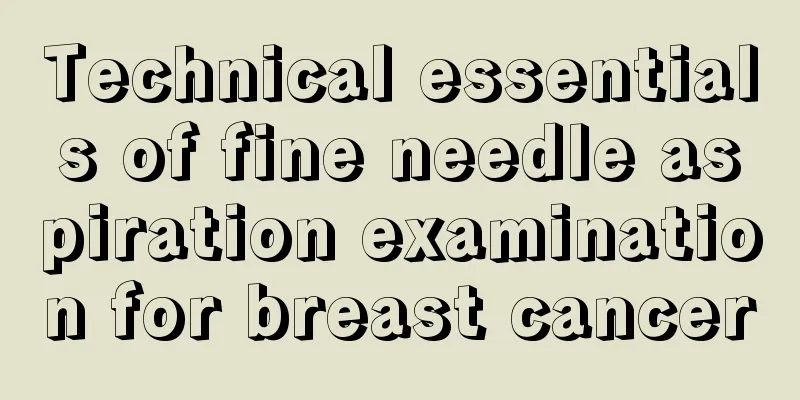Technical essentials of fine needle aspiration examination for breast cancer

|
At present, there are very few units in the country that can perform high-quality fine needle aspiration cytology diagnosis and immunohistochemistry examinations, and there are only a few units in our province that can do so. For example, the Pathology External Examination Center of the Department of Pathology of Fujian Medical University has a high diagnostic accuracy rate and a large number of cases, and is at the advanced level in the country. To carry out fine needle aspiration cytology diagnosis, it is necessary to have: ① perfect and accurate puncture and aspiration technology ② excellent smear and staining technology ③ experienced pathological cytologists to make correct judgments on smears based on clinical data. During puncture, the patient lies on his back, with the affected upper limb raised or placed behind the head. If necessary, a thin pillow can be placed on the back to make the convexity of the mass shallower. After local disinfection, fix the mass with the left hand. For superficial masses, especially small masses, the left middle finger and index finger can be used to hold and fix them. If the mass is large or deep, the thumb and index finger can be used to hold and fix it, and the skin on the superficial surface of the mass is tense to make the mass relatively shallower. Then hold the syringe in the right hand. Insert the mass vertically. When the needle tip reaches the center of the mass, withdraw the syringe plug to create negative pressure. While maintaining the negative pressure, poke or rotate the needle up and down, left and right, and forward and backward several times, then completely remove the negative pressure and pull out the needle. Remove the needle. After the air is inhaled into the syringe, press the needle again. Push out the absorbed tissue, quickly smear it, and divide it into dry and wet pieces, which are fixed, stained and examined under a microscope. Push the remaining tissue in the needle into a small test tube filled with saline, centrifuge it to make a cell block for later use. Note that during the puncture process, before the needle tip pierces the mass, negative pressure cannot be applied to prevent blood or fat tissue from mixing in and affecting the result. When the needle tip pierces the mass, there is generally a sense of touch, and the feel of masses of different natures is different. For example, cystic masses often feel empty and liquid can be drawn; fibroadenoma feels like piercing hard rubber, and it is not easy to suck out the tissue; and breast cancer feels like piercing uncooked potatoes, and it is easy to suck out the tissue. During the needle removal process, be sure to completely remove the negative pressure to prevent the tissue from being sucked into the syringe and cannot be pushed out. To prevent the formation of local hematoma during puncture, the local area should be gently pressed for 3 to 6 minutes after the operation is completed. When puncturing a small mass, due to improper force, the needle piercing the chest cavity and damaging the alveoli can cause pneumothorax. To avoid this, the mass can be pushed to the ribs to fix it before puncturing, or the needle can be inserted in a direction slightly parallel to the chest wall. 2. Clinical Evaluation After the 1970s, foreign literature reported that the accuracy of fine needle aspiration cytology for breast lumps reached about 90%, the positive rate of breast cancer was 80-95%, the false positive rate was 1% to 2%, and the false negative rate was 5% to 15%. Most patients who undergo fine needle aspiration cytology are those who are difficult to diagnose by clinical physical examination and imaging examination, but its diagnostic accuracy is higher than that of clinical physical examination and other auxiliary examinations, and the false negative rate is low. In European countries, it is popular to combine fine needle aspiration cytology with clinical palpation and X-ray film. According to data, the misdiagnosis rate of 2460 cases of breast cancer is only 1 case. Fine needle aspiration cytology diagnosis can also be combined with LCD thermal imaging or B-ultrasound to improve the diagnosis rate. The main factors leading to false negative results in fine needle aspiration cytology are: ① The diameter of the mass is small and the puncture is inaccurate. However, the larger the mass, the higher the positive rate. When the mass diameter is >5cm, the positive rate does not increase. This is because the mass is too large and often combined with degeneration, necrosis, bleeding or infection, which affects the accuracy of diagnosis; ② It is related to the biological characteristics of cancer. Medullary carcinoma, especially those with lymphatic invasion, has a high positive rate, while lobular carcinoma and intraductal carcinoma generally have a low positive rate. Because the number of lobular carcinoma tumor cells is small, it is not easy to extract enough cancer cells; and intraductal carcinoma is confined to the duct, so it is not easy to accurately puncture and extract materials. In addition, cystic tumors are also prone to false negatives because tumor cells are only on the cyst wall; ③ Misreading errors, such as well-differentiated carcinoma and benign proliferative lesions are often difficult to distinguish in cytology; ④ Improper control of negative pressure during puncture, improper smear technique, careless microscopy and other human factors can also cause false negatives. In order to reduce false negatives, clinical palpation and other auxiliary examinations must be combined. For patients with clinically highly suspected malignancy but negative cytological examinations, repeated puncture or core needle biopsy should be performed if necessary. There are few reports of false positives. Actively growing breast fibroids and intraductal papilloma are easily misdiagnosed as malignant tumors. In addition, long-term use of corticosteroids and chronic mastitis with epithelial metaplasia are also prone to misdiagnosis. III. Progress In recent years, the diagnostic value of fine needle aspiration has been further improved by combining it with other new technologies. Immunocytochemistry examination using cell specimens provided by needle aspiration makes the tissue origin of some tumors clearer. In breast cancer, hormone receptor (ER, PR) detection, Her-2, p53 and other oncogenes, tumor suppressor gene detection and topoisomerase and other drug-resistant gene products detection can be performed. There is also computer imaging software that combines cell image indicators with DNA analysis and AgNOR (nucleolar component region) to form a comprehensive indicator. It provides a good objective indicator for distinguishing benign and malignant tumor cells. In addition, cells can also be cultured as live cells to study the sensitivity to anticancer drugs and the sensitivity to tumor growth factors. |
<<: How long can you live with breast cancer lymph node metastasis
>>: How to check for early breast cancer
Recommend
Is there any error in B-ultrasound
The accuracy of B-ultrasound examination is still...
What are the examination and diagnosis methods for colon cancer?
What are the examination and diagnosis methods fo...
Upper incisor correction
Everyone wants their teeth to be straight and whi...
Drinking hot water and mineral water, what are their benefits
A glass of water every morning will bring you hap...
Symptoms of skin cancer cannot be ignored
Skin cancer is a common oncology disease, and the...
The difference between octopus, cuttlefish and squid
Some of you may think that octopus, cuttlefish an...
Method of removing formaldehyde with vinegar
Vinegar is a very common thing in people's li...
The stool shape becomes flatter and thinner
There are many reasons why the stool becomes flat...
Denture care and maintenance
In our daily life, many people cannot eat normall...
Analysis of technical pathways for laparoscopic gastric cancer surgery
Since Goh et al. applied laparoscopic technology ...
Can tongue cancer be cured? How to treat tongue cancer
Tongue cancer cannot be completely cured through ...
Is bile duct cancer hereditary?
Biliary duct cancer is a malignant tumor. People ...
What to do if your cheek hurts due to inflammation
Everyone is very familiar with the term "get...
Can lettuce and milk be eaten together
Vegetables and milk are both familiar foods in ou...
Does blood clot in urine necessarily mean bladder cancer?
Bladder cancer is a malignant disease that can ca...









